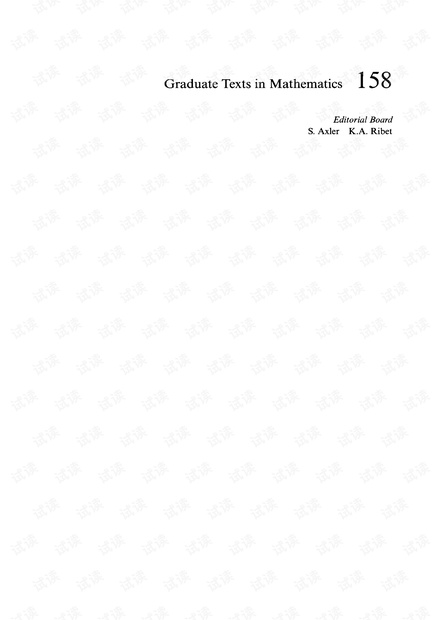没有合适的资源?快使用搜索试试~ 我知道了~
首页Field Theory - Steven Roman
资源详情
资源评论
资源推荐

Graduate Texts in Mathematics
158
Editorial Board
S. Axler K.A. Ribet

Graduate Texts in Mathematics
1 TAKEUTI]ZARING. Introduction to
Axiomatic Set Theory. 2nd ed.
2 OXTOBY. Measure and Category. 2nd ed.
3 SCHAEFER. Topological Vector Spaces.
2nd ed.
4 HILTON/STAMMBACH. A Course in
Homological Algebra. 2nd ed.
5 MAC LANE. Categories for the Working
Mathematician. 2nd ed.
6 HUGHES/PIPER. Projective Planes.
7 J.-P. SERRE. A Course in Arithmetic.
8 TAKEUTI/ZARING. Axiomatic Set Theory.
9 HUMPHREYS. Introduction to Lie
Algebras and Representation Theory.
10 COHEN. A Course in Simple Homotopy
Theory.
11 CONWAY. Functions of One Complex
Variable I. 2nd ed.
12 BEALS. Advanced Mathematical Analysis.
13 ANDERSON/FULLER. Rings and
Categories of Modules. 2nd ed.
14 GOLUBITSKY/GUILLEMIN. Stable
Mappings and Their Singularities.
15 BERBERIAN. Lectures in Functional
Analysis and Operator Theory.
16 WINTER. The Structure of Fields.
17 ROSENBLATr. Random Processes. 2nd ed.
18 HALMOS. Measure Theory.
19 HALMOS. A Hilbert Space Problem
Book. 2nd ed.
20 HUSEMOLLER. Fibre Bundles. 3rd ed.
21 HUMPHREYS. Linear Algebraic Groups.
22 BARNES/MACK. An Algebraic
Introduction to Mathematical Logic.
23 GREUB. Linear Algebra. 4th ed.
24 HOLMES. Geometric Functional
Analysis and Its Applications.
25 HEWITT/STROMBERG. Real and Abstract
Analysis.
26 MANES. Algebraic Theories.
27 KELLEY. General Topology.
28 ZARISKI]SAMUEL. Commutative
Algebra. Vol. I.
29 ZARISKI/SAMUEL. Commutative
Algebra. Vol. II.
30 JACOBSON. Lectures in Abstract Algebra
I. Basic Concepts.
31 JACOBSON. Lectures in Abstract Algebra
II. Linear Algebra.
32 JACOBSON. Lectures in Abstract Algebra
III. Theory of Fields and Galois
Theory.
33 HIRSCH. Differential Topology.
34 SPITZER. Principles of Random Walk.
2nd ed.
35 ALEXANDER/WERMER. Several Complex
Variables and Banach Algebras. 3rd ed.
36 KELLEY/NAMIOKA et al. Linear
Topological Spaces.
37 MONK. Mathematical Logic.
38 GRAUERT/FRITZSCHE. Several Complex
Variables.
39 ARVESON. An Invitation to C*-Algebras.
40 KEMENY/SNELL/KNAPP. Denumerable
Markov Chains. 2nd ed.
41 APOSTOL. Modular Functions and
Dirichlet Series in Number Theory.
2nd ed.
42 J.-P. SERRE. Linear Representations of
Finite Groups.
43 GILLMAN/JERISON. Rings of
Continuous Functions.
44 KENDIG. Elementary Algebraic
Geometry.
45 LOEVE. Probability Theory I. 4th ed.
46 LOEVE. Probability Theory II. 4th ed.
47 MOISE. Geometric Topology in
Dimensions 2 and 3.
48 SACHS/WU. General Relativity for
Mathematicians.
49 GRUENBERG/WEIR. Linear Geometry.
2nd ed.
50 EDWARDS. Fermat's Last Theorem.
51 KLINGENBERG. A Course in Differential
Geometry.
52 HARTSHORNE. Algebraic Geometry.
53 MANIN. A Course in Mathematical Logic.
54 GRAVER/WATKINS. Combinatorics with
Emphasis on the Theory of Graphs.
55 BROWN/PEARCY. Introduction to
Operator Theory I: Elements of
Functional Analysis.
56 MASSEY. Algebraic Topology: An
Introduction.
57 CROWELL/FOX. Introduction to Knot
Theory.
58 KOBLITZ. p-adic Numbers, p-adic
Analysis, and Zeta-Functions. 2nd ed.
59 LANG. Cyclotomic Fields.
60 ARNOLD. Mathematical Methods in
Classical Mechanics. 2nd ed.
61 WHITEHEAD. Elements of Homotopy
Theory.
62 KARGAPOLOV/MERIZJAKOV.
Fundamentals of the Theory of Groups.
63 BOLLOBAS. Graph Theory.
(continued after index)

Steven Roman
Field Theory
Second Edition
With 18 Illustrations
Springer

To Donna

Preface
This book presents the basic theory of fields, starting more or less from the
beginning. It is suitable for a graduate course in field theory, or independent
study. The reader is expected to have taken an undergraduate course in abstract
algebra, not so much for the material it contains but in order to gain a certain
level of .mathematical maturity
The book begins with a preliminary chapter (Chapter 0), which is designed to be
quickly scanned or skipped and used as a reference if needed. The remainder of
the book is divided into three parts.
Part 1, entitled , begins with a chapter on polynomials. ChapterField Extensions
2 is devoted to various types of field extensions, including finite, finitely
generated, algebraic and normal. Chapter 3 takes a close look at the issue of
separability. In my classes, I generally cover only Sections 3.1 to 3.4 (on perfect
fields). Chapter 4 is devoted to algebraic independence, starting with the general
notion of a dependence relation and concluding with Luroth's theorem on
intermediate fields of a simple transcendental extension.
Part 2 of the book is entitled . Chapter 5 examines Galois Theory Galois theory
from an historical perspective, discussing the contributions from Lagrange,
Vandermonde, Gauss, Newton, and others that led to the development of the
theory. I have also included a very brief look at the very brief life of Galois
himself.
Chapter 6 begins with the notion of a Galois correspondence between two
partially ordered sets, and then specializes to the Galois correspondence of a
field extension, concluding with a brief discussion of the Krull topology. In
Chapter 7, we discuss the Galois theory of equations. In Chapter 8, we view a
field extension of as a vector space over .,- -
Chapter 9 and Chapter 10 are devoted to finite fields, although this material can
be omitted in order to reach the topic of solvability by radicals more quickly.
Mo¨bius inversion is used in a few places, so an appendix has been included on
this subject.
剩余329页未读,继续阅读
lilinacy
- 粉丝: 0
- 资源: 1
上传资源 快速赚钱
 我的内容管理
收起
我的内容管理
收起
 我的资源
快来上传第一个资源
我的资源
快来上传第一个资源
 我的收益 登录查看自己的收益
我的收益 登录查看自己的收益 我的积分
登录查看自己的积分
我的积分
登录查看自己的积分
 我的C币
登录后查看C币余额
我的C币
登录后查看C币余额
 我的收藏
我的收藏  我的下载
我的下载  下载帮助
下载帮助

会员权益专享
最新资源
- 27页智慧街道信息化建设综合解决方案.pptx
- 计算机二级Ms-Office选择题汇总.doc
- 单链表的插入和删除实验报告 (2).docx
- 单链表的插入和删除实验报告.pdf
- 物联网智能终端项目设备管理方案.pdf
- 如何打造品牌的模式.doc
- 样式控制与页面布局.pdf
- 武汉理工Java实验报告(二).docx
- 2021线上新品消费趋势报告.pdf
- 第3章 Matlab中的矩阵及其运算.docx
- 基于Web的人力资源管理系统的必要性和可行性.doc
- 基于一阶倒立摆的matlab仿真实验.doc
- 速运公司物流管理模式研究教材
- 大数据与管理.pptx
- 单片机课程设计之步进电机.doc
- 大数据与数据挖掘.pptx
资源上传下载、课程学习等过程中有任何疑问或建议,欢迎提出宝贵意见哦~我们会及时处理!
点击此处反馈



安全验证
文档复制为VIP权益,开通VIP直接复制
 信息提交成功
信息提交成功
评论0